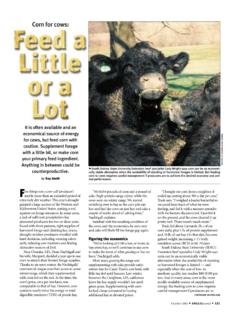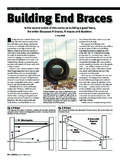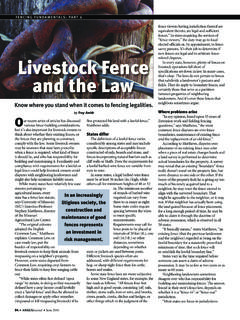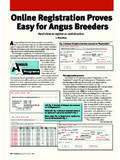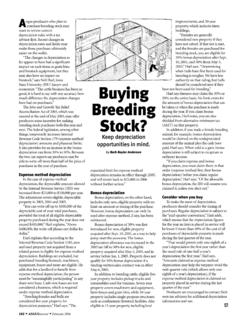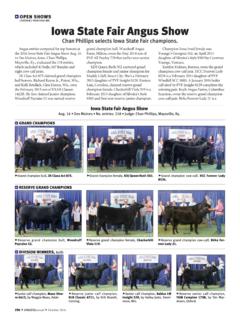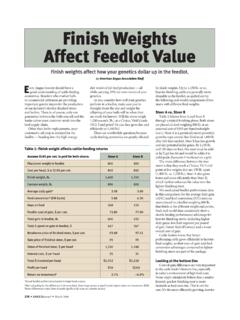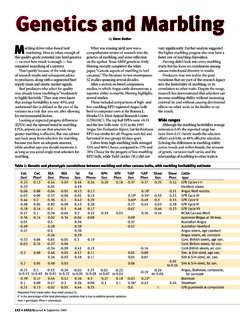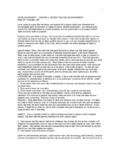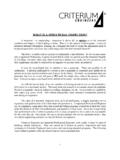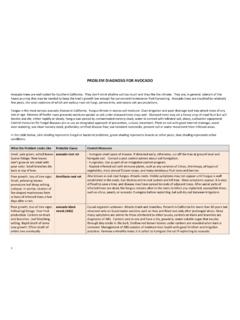Transcription of The bacteria thatcause footrotexisteverywhere …
1 Your herd is surrounded bythe bacteria that cause foot line, the germ existseverywhere cattle do. But likeany invader, the bacteria thatcause foot rot need a point ofentry before they can inflictcasualties. They only become aproblem when they make theirway into the rot actually is a disease ofthe soft tissues of the skin, not ofthe hoof, explains Dee Whittier,professor of productionmanagement medicine andExtension cattle specialist atVirginia Tech. If you call the linebetween the hoof wall and thefoot the coronary band, it s thetissues that are above thatcoronary band that are infectedwhen we have foot rot. The danger is it can alwaysgo into deeper tissues there, so itcan get into tendons, tendonsheaths and joints if it s notproperly treated, he continues. Those tissues often don t healvery well, and we can end upwith permanent lameness if wedon t treat them appropriately. The organism most oftenattributed as the cause of foot rotis Fusobacterium necrophorum,Whittier says. There can be a number ofother bacteria that can get intothese infections, Whittier says.
2 But that s kind of the necessaryone. It s an organism that lives inthe environments where cattleare. You can culture it out of themanure and out of dirt and otherfarm sources. So what is lackingfor a case of foot rot is a woundthat allows this bacteria to get in. Entry of the bacteria can beaccomplished in several ways:mechanical injury to the foot,softening and thinning of theinterdigital skin by puncturewounds, continuous exposure towet conditions, or exposure toextremely dry conditions thatcause cracks to develop in or frozen ground,stones, stubble, nails, wire, andother objects can provide awound or entryway forinfection. However, muddy, wetlots and pens can compound thechances of a foot rot outbreak bysoftening the skin above thehoof. Conversely, drought-stricken conditions also cancause the skin to become dryand to split matter how it gains entry,the bacteria spreads quicklyonce it s inside the they find an entrancepoint, the bacteria kill anddamage tissue, causing swellingand pain, Whittier says.
3 Thediscomfort is the result of thebody s reaction to the poisonsthe bacteria produces once itstarts to proper diagnosisIn cases of foot rot, Whittiersays, Lameness is the primarysign, but there are a number ofreasons why cows becomelame. If the swelling is just abovethe hoof wall, particularly in thespace between the toes, it s prettymuch diagnostic of foot rot, hesays. Sometimes with a realearly case, you won t see muchswelling, but if swelling is there,it means there s foot rot. Bob Larson, a beefveterinarian at the University ofMissouri, agrees with Whittierabout lameness being the firstsign of a foot rot case. However,he cautions producers tothoroughly examine theiranimals to make sure it s notsomething else, such as apuncture or an embeddedobject. I do encourage anybody[who] sees their cattle limpingto get them in a chute andactually pick up the foot andlook at it because you can befooled, he says. Whileinspecting the foot, the firstthing he tries to do is rule outthe presence of a nail or glass,which must be removed first.
4 Inthe case of an embedded object,he generally treats withantibiotics and moves theanimal to a dry area where it canheal, very similar to treating acase of foot rot. There are all sorts of injuriesto the hooves themselves, Whittier says. There are cracks,splits and punctures and otherinjuries that happen to the hoofwall itself. Of course, those aredifferent diseases and need to betreated in a different way. While it s tempting to treatevery case of lameness withantibiotic, that may not beappropriate, Whittier says. Since antibiotics are veryeffective against foot rot, that sgreat in that case. But antibioticsdon t treat many other forms oflameness. So I think there arelots of mistakes made. Cowsobviously don t get better ifthey ve got a puncture in theirhoof and are just treated withantibiotics. FootrotoutbreaksIt s important to distinguishbetween an occasional case offoot rot and a real outbreak,Whittier says. It s hard to predictwhen an occasional case willoccur. Any cow, calf or bull anytime can happen to get a case offoot rot, he says.
5 Generally,what happens is that an injuryprovides an opening for thebacteria to enter the goes on to say thatgenerally two things are presentduring a foot rot outbreak. One242 ANGUSJ ournal August 2001@Above: A mechanical injury caused by hard or frozen ground, stones, stubble, nails, wire, or other objects can provide openings in the skin between thetoes, which allows the bacteria that cause foot rot an entrance into the bacteria thatcause footrotexisteverywhere cattledo. Preventing infectionsmeansminimizing waysthebacteria can invade the Zieschis conditions that are going tosoften the skin between thetoes. The other is rough footingthat causes damage to the skinbetween the toes. Nearly all of the outbreaksof foot rot can be associatedwith either wet conditions,where the skin becomes wetand soft, or with footingconditions so that there s injuryto the space between the toes. Ithink that s much, much morecommon than any nutritionaldeficiency. However, Whittier admitsthere is an ongoing discussionabout whether mineraldeficiencies make an animalmore susceptible to foot rot.
6 For a long while we thoughtthat feeding iodinated saltshelped to prevent foot rot, andpeople thought that that wassomehow improving the healthof the skin, he explains. Theother thought was that if iodinepassed through in the manureit was kind of a disinfectant tothe manure and would decreasethe number of organisms thatwere there. I think thatveterinarians generally acceptthese theories less these days. Another preventivemanagement practice iswalking cattle through adisinfectant solution (orfootbath). Walking cattlethrough a 3% formalinfootbath, a 5% copper sulfatefootbath, or mixed powderedcopper sulfate and lime twice aday decreases the incidence offoot rot. Zinc methionine alsohas been recommended forboth treatment and footbaths are oftenused in the dairy industry,Whittier says their use isn tapplicable to most beefoperations unless cows are in adrylot footbaths aren tusually practical, he says theycan help in a couple of ways. We put things in thosefootbaths that will harden ortoughen up the skin, and thenwe also put disinfectants inthere that will kill theorganisms that are present onthe foot.
7 So if there is a littleinjury, they re a lot less likely toend up with a foot rotinfection. I think that, in most cases,we can just change the footingand get cattle out of pastures orareas where it s really wet orwhere there s potential for a lotof injury, Whittier says, addingthat may be easier than walkingthem through a I think that any animal thatgets a case of the disease isgoing to experience some loss, Whittier says. They don t don t walk around. Theyprobably don t drink normally. The result is a loss in weightand condition. Of course, real disastersoccur if outbreaks occur duringthe breeding season and you vegot bulls that are not breedingcows, he adds. Likewise, thecows are a lot less likely to getpregnant if they have a case offoot rot. Usually, if caught in its earlystages, a case of foot rot can behealed rapidly and successfully. I see cows that have a veryswollen foot and a lot of deadtissue. We give them anantibiotic and maybe go theextra step of picking their footup and cleaning the dead tissueout of there.
8 In just two or threedays, they re essentially back tonormal. I m impressed at howquickly they can respond. If left untreated, foot rot canlead to more-serious problemsif it spreads to the deepertissues of the foot. As a veterinarian, I getcalled for a cow that has footrot that won t get better. When Iexamine the cow, I find out she@Continuous exposure to wet conditions is another factor in foot rot may occur in areas where cattle are standing constantly in wet,muddy areas. To decrease the chance of an outbreak, producers should tryto keep areas around bunks and troughs an animal becomes lame, it s not always a case of footrot. There is a plethora of other things that can cause an animal tolimp. One example is fescue foot. Most of the fescue grown is in the southeastern part of theUnited States, says Bob Larson, a beefveterinarian at theUniversity of Missouri. So cattle coming on those pastures orcoming off of those pastures, particularly if they re not acclimated,can have some lameness and hoof problems because of that.
9 Fescue foot can result when cattle consume fescue infectedwith a fungus that does not harm the plant but produces asubstance that, when eaten by cattle, causes constriction of theblood vessels around the foot. In cold weather, you can actually have cases where the bloodflow is completely shut off to the hoof, he says. You can lose thehoof. The animal will appear lame and there will be swelling inthat foot. The animal may show other symptoms of fescuetoxicosis, such as a rough hair coat and a high body close inspection of the foot won t reveal a lesion like you dfind in the case of foot rot, Larson explains. It s really a blood-flow problem to the foot. If it s a fescue foot problem, then the antibiotics we use forfoot rot are not going to be helpful, Larson says. So it s good toknow as you re going into it. For almost any cut or foot rot, we regoing to treat with antibiotics and try to get the animal into asclean and dry [a] place as we says there really isn t a treatment for fescue foot, otherthan getting the animals off the contaminated hay or pasture.
10 If it s mild, they ll return to production, but they may havetrouble catching up with their peers, he footCONTINUED ON PAGE244 August 2001 ANGUSJ ournal 243actually has infection in thebone or joint of the foot, Whittier says. Whether thatstarted with an injury or withfoot rot, that s hard for me tofigure out. But I m sure that apercentage of them start withfoot rots that are not picked upearly enough. The complications are thatwe get into tissues (tendons,tendon sheaths, bones andjoints) that don t heal as quicklyas the skin and subcutaneoustissues, he continues. Most animals [do] recoververy well, Larson says. Once ina while, if the joint above thehoof becomes infected, we haveto use a surgical procedure toremove one of the claws toallow that to heal. That isconsidered a salvage procedure,and those animals are intendedto get well, and then take themto slaughter. You wouldn t keepa one-toed animal around verylong. Treatment I believe that every cow, calfor bull that s diagnosed with acase of foot rot deserves carefulexamination of that foot, Whittier says.
